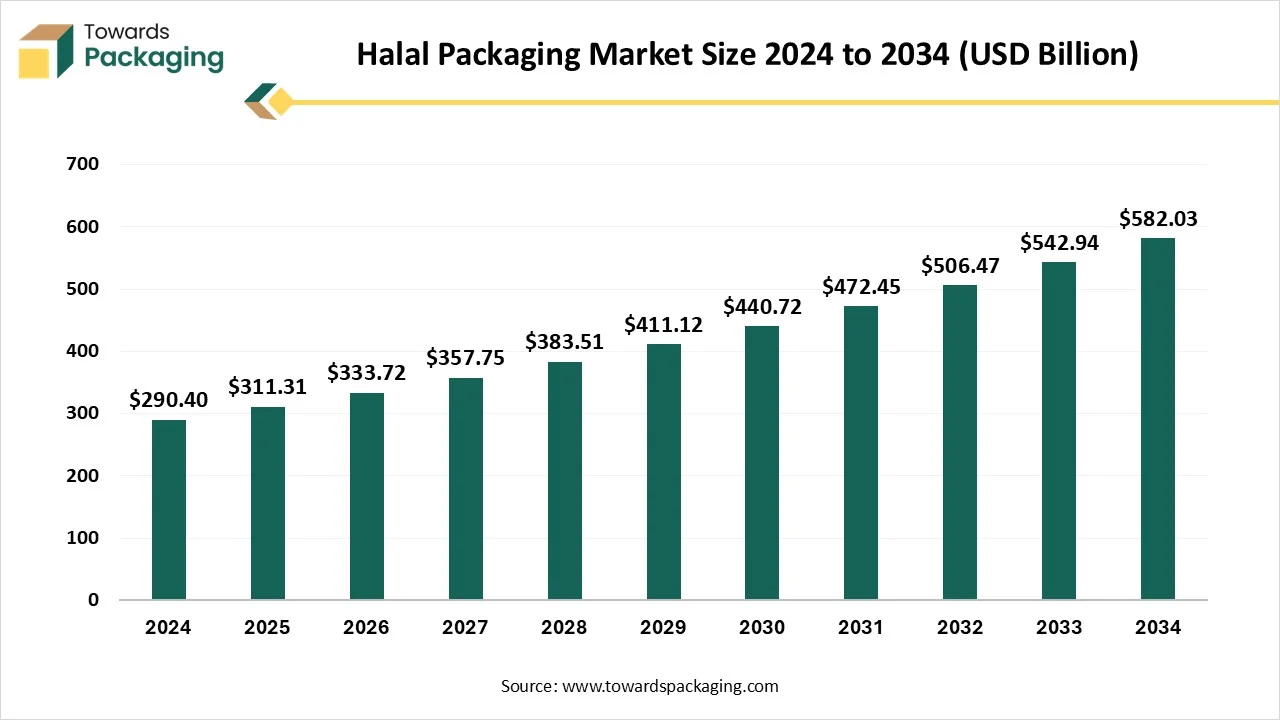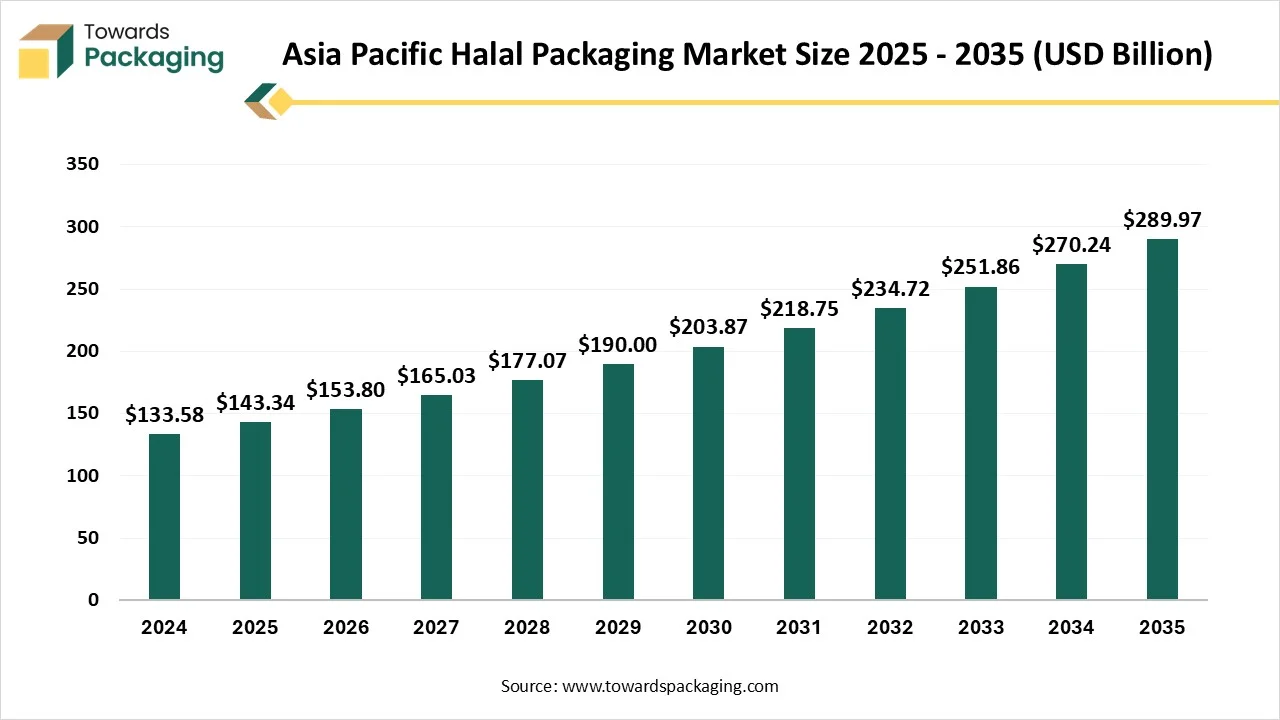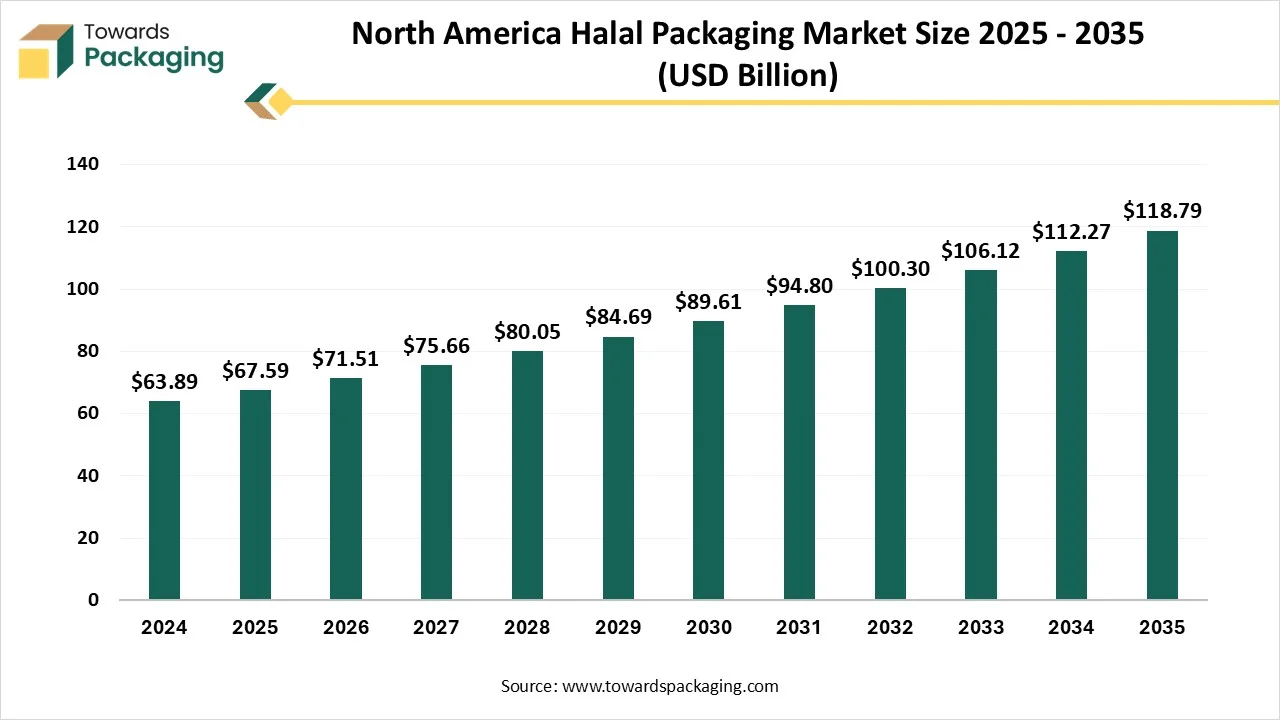December 2025
The halal packaging market is forecasted to expand from USD 311.31 billion in 2025 to USD 626.94 billion by 2035, growing at a CAGR of 7.20% from 2025 to 2034. The demand is being driven by the growing demand for Halal-certified products across different regions. As users become more conscious of religious and cultural dietary needs, packaging solutions make sure that compliance and safety are in high demand.

Halal refers to “lawful” or “ permissible” in terms of Islamic laws, which define what is acceptable for usage and utilised by Muslims. Beyond food, halal extends to products like pharmaceuticals, cosmetics, and chemicals that display ethical and good-quality standards across global industries. The ideas make sure that products are free from barrier substances and produced, packaged, and stored with rigid rules to ethical guidelines and cleanliness.
For organizations, penetrating the halal industry serves as a powerful opportunity to align with the demands of over 1.9 million halal users globally, expanding market, promoting trust and reach, and meeting global demand for good products.
Artificial Intelligence is also developing food safety by analysing pollutants, growing traceability, and protecting against foodborne diseases. So the AI-driven image processing and spectroscopy classify toxins, bacteria, and foreign particles in food products, which lowers the risk of contamination. It also examines manufacturing data to predict and protect against food safety risks by assisting businesses in complying with Hazard Analysis and Critical Control Points (HACCP) guidelines.
Furthermore, one of the most crucial areas of growth in the Halal food sector is the automation of slaughterhouses. Organizations utilise technology to make sure that animals are handled as per strict Halal needs and demands. For example, accurate cutting and smooth blood draining are now achieved through automated machines, while sensors track and maintain blade sharpness. This ensures compliance with Halal standards and develops complete productivity and efficiency.
| Organization | Country | Focus |
| Islamic Services of America (ISA) | USA | Different items that count as cosmetics. |
| Department of Islamic Development Malaysia (JAKIM) | Malaysia | Different products, which count as cosmetics, are present in Southeast Asia |
| The Halal Food Authority (HFA) | Singapore | Different products that lead to cosmetics. |
| Hala Certification Services | Switzerland | Worldwide reach, that have different products, including cosmetics. |
| The Gulf Cooperation Council (GCC) | Regional | Personalized machine for different products that include cosmetics, tailored in the GCC countries. |
The primary packaging segment has dominated the market with a 52% share in 2024, as this kind of packaging is utilised for Halal products that should be made from Halal-compliant materials and do not have any non-Halal substances, such as animal-derived gelatin or alcohol-based coating. It should be free from pollutant risk and ensure the reliability of the product.
Packaging suppliers should obtain Halal certification to confirm compliance. Furthermore, the packaging procedure should be tracked to prevent linking with non-Halla materials during handling and storage. Accurate labelling must also be used, precisely showing Halal certification. Regular checking and audits should be used to cross-verify adherence to Halal packaging needs, which ensures user confidence and regulatory compliance.
The secondary packaging segment is predicted to be the fastest in the market with a 7.90 % share during the forecast period. Secondary packaging should be handled and stored separately from any non-halal products. If facilities are shared, a rigid cleaning process as per the Islamic needs and demands must be followed to protect against accidental pollutants. Several secondary packaging types can be utilised for the halal products, if the materials and procedures are compliant. The choice for the packaging relies on the product's demand, such as moisture opposition or shelf life.
The plastic segment has dominated the market with a 39% share in 2024, as polypropylene (PP) and HDPE are two kinds of plastics prevalently used in the packaging sector, but they have several characteristics. HDPE is known for its power and resistance to chemicals, which makes it a famous choice for medicine bottles, jerry cans, and chemical containers.
On the other hand, PP has perfect heat resistance and is frequently utilised as the main material for creating buckets and cans in the food and beverage sector. The choice between PP and HDPE relies on the particular use demands and the desired material characteristics.
The paper and paperboard material segment is expected to be the fastest growing in the market with 8.10 % share during the forecast period. For the paper and paperboard to be halal, producers must make sure that the packaging materials and all of their additives are free from any ingredients, like animal-derived glues or fats. This counts on making sure that raw materials, coating, and processing aids are being sourced from the halal-compliant origins and that no pollutants occur during manufacturing. Paper and paperboard created from the virgin wood or non-wood plant fibres like bagasse, bamboo, or straw are usually considered safe as long as non-halal chemicals are utilised in the processing. It utilises the 100% virgin pulp, which is frequently chosen for diet food links.
The conventional packaging segment has dominated the halal packaging market with a 44% share in 2024, as it aims to make a food safety management machine that aligns with the different safety and quality standards needed for direct food contact materials. The latest manufacturing facility has been filled with, among others, dusters, air showers with great smoothness particulate air (HEPA) filters, and antibacterial flooring. The latest facility has also earned a certification of compliance with Indonesia’s halal rules and is in line with the World Health Organization’s perfect production practices.
The sustainable and biodegradable packaging segment is expected to be the fastest growing in the market with 8.80% share during the forecast period. One of the main elements of halal food manufacturing is the humane diagnosis of animals. Zabiha, halal slaughter, which needs animals to be treated with care and respect throughout their lives, not just during the period of slaughter. The rules are compulsory as animals must be healthy at the time of slaughter, the slaughter procedure should be fast, that is, minimal pain. They must not be linked to mistreatment, cruelty, or unnecessary stress.
The name of God(Allah) must be included during slaughter, which gives importance to spiritual accountability.
The food and beverage segment has dominated the market in 2024 with a 58% share, as Halal-certified food and beverages (F&B) include a wide range of products that meet Islamic dietary laws. Only animals that are slaughtered as per the Halal rules are permissible. This makes sure that specific procedures of slaughtering and humane treatment are followed. From nuts and hips to candies and chocolates, these products should have non-Halal certified facilities, such as gelatin or alcohol( that come from non-Halal animal sources.
Cheese, milk, yoghurt, and other dairy products must be free from non-Halal additives and manufactured in Halal-certified facilities.
The cosmetics and personal care segment is expected to be the fastest growing with 8% share during the forecast period. Halal cosmetics are personal care and beauty products that are produced using ingredients which is permissible under Islamic Shariah Law. Several regular cosmetics have high or focused levels of ethyl alcohol, which is banned in Islam. They must not be counted in any materials that come from human bodies, as ingredients are being banned by Islamic laws, or animals that are not slaughtered as per the Halal guidelines. The manufacturing procedure must meet Halal standards, making sure that ethical diagnosis and cleanliness of all are ensured. Ingredients such as pork gelatin or collagen are totally avoided.
The direct sales segment has dominated the market with a 45% share in 2024, as direct sales of the halal items include selling items that match the Islamic dietary laws (Sharia) directly, which come from the manufacturer to the user. This strategy is heavily prevalent, specifically through e-commerce and tailored direct-to-consumer channels, as it serves higher assurance and transparency of authenticity to customers. Direct sales enable organisations to reach Muslim users in areas that may not have any halal-certified items in mainstream retail shops.
The online /E-commerce segment is expected to be the fastest-growing in the market with 8.40% during the forecast period. E-commerce sales of the halal items are a developing industry of the overall halal industry, which is being driven by the Muslim population, developed user demand for the ethical products, and technological growth. While there is still a little less space for complete halal sales, the e-commerce segment development is overtaking regular retail channels, which serves a huge convenience and reliability to consumers.

Asia Pacific dominated the market in 2024 with a 46% share, as the Asia Pacific has a substantial portion of the overall Muslim population, specifically in countries like Malaysia, Indonesia, Pakistan, and India. This big user base is the initial driver for the halal packaging demand. Several Asia Pacific countries have a rigid and compulsory halal certification procedure. For instance, Indonesia has rigid regulations that require certification for every marketed product, which makes a strong urge for complaint packaging. Malaysia’s regulatory bodies, such as JAKIM, are also highly respected and encouraged.
India is currently developing itself as a major player in the international Halal meat industry. Growing urge for Halal-certified items from regions including the Gulf Cooperation Council (GCC), North Africa, and Southeast Asia has developed India’s role in the industry. To align with the regulatory demands of importing countries, India has implemented the India Conformity Assessment Scheme(i-CAS).
Main importers of Indian Halal meat include nations like Indonesia, Egypt, Malaysia, Iran, and GCC countries, which support Halal standards as a compulsory need for the exporters.
The Middle East and Africa are predicted to be the fastest-growing regions in the market with an 8.20% share during the forecast period. The urge for halal packaging in the Middle East and Africa is being driven by the region’s big Muslim population, growing consumer income, and highly rigid regulatory standards. The region is home to the main space of the worldwide Muslim population, which creates a constant and large-scale urge for products that align with Islamic law and adhere to packaging. Developed consumer purchasing power and a greater alertness of halal compliance have led to a bigger demand for certified products. Users are also becoming more inclined to fund ethically and organically sourced items, which frequently meet halal standards.
Several countries in the MEA region have developed power and a big compulsory halal certification procedure. For instance, the UAE’s Emirates Authority for Standardization and Metrology (ESMA) and Saudi Arabia’s Saudi Food and Drug Authority (SFDA) have created rigid compliance, specifically for imported goods.
The urge for halal packaging in the UAE is substantial and developing, which is being driven by a large Muslim population, developed consumer awareness, and rigid governmental regulations, which lead to checking and ethical documenting of products. The UAE region has a large Muslim population, including a main expatriate community, which constantly demands items that comply with Islamic dietary laws. Furthermore, several non-muslim users receive halal-certified products as high-quality, hygienic, and perfect, further boosting demand.

North America expects the fastest growth in the market during the forecast period. Key drivers include the rising global Muslim population, increasing demand for halalcertified foods and goods, stricter regulatory requirements for halal compliance, and the surge in ecommerce and export trade which necessitates tamperproof, traceable packaging solutions. Sustainability is also playing a role: manufacturers are innovating halalcertified, ecofriendly materials to appeal to both Muslim and nonMuslim consumers who associate halal certification with ethical, highquality, and safe products.
Key drivers include increasing demand for halalcertified products (both from Muslim consumers and nonMuslims drawn to ethical, cleanlabel goods), greater retail availability, growing emphasis on traceability and certification in packaging, and the dominance of rigidtype packaging formats in this segment.
By Packaging Type
By Material Type
By Packaging Technology
By Application
By Distribution Channel
By Region
December 2025
December 2025
December 2025
December 2025